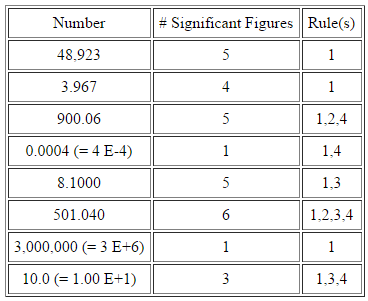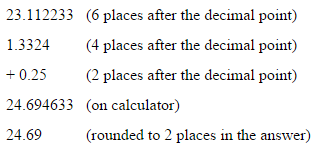Significant figures are critical when reporting scientific data because they give the reader an idea of how well you could actually measure/report your data. Before looking at a few examples, let's summarize the rules for significant figures.
- ALL non-zero numbers (1,2,3,4,5,6,7,8,9) are ALWAYS significant.
- ALL zeroes between non-zero numbers are ALWAYS significant.
- ALL zeroes which are SIMULTANEOUSLY to the right of the decimal point AND at the end of the number are ALWAYS significant.
- ALL zeroes which are to the left of a written decimal point and are in a number >= 10 are ALWAYS significant.
A helpful way to check rules 3 and 4 is to write the number in scientific notation. If you can/must get rid of the zeroes, then they are NOT significant.
Examples: How many significant figures are present in the following numbers?
Addition and Subtraction
When adding or subtracting numbers, count the NUMBER OF DECIMAL PLACES to determine the number of significant figures. The answer cannot CONTAIN MORE PLACES AFTER THE DECIMAL POINT THAN THE SMALLEST NUMBER OF DECIMAL PLACES in the numbers being added or subtracted.
Multiplication and Division
When multiplying or dividing numbers, count the NUMBER OF SIGNIFICANT FIGURES. The answer cannot CONTAIN MORE SIGNIFICANT FIGURES THAN THE NUMBER BEING MULTIPLIED OR DIVIDED with the LEAST NUMBER OF SIGNIFICANT FIGURES.




